-
Posts
1,011 -
Joined
-
Last visited
Content Type
Profiles
Forums
Gallery
Events
Posts posted by flyer
-
-
Thank you, Michael. But I’m afraid that any compliments for elegance should rather go to the Surveyor of the Navy, John Williams, who designed the very properly named swan class.
(I’m glad; he didn’t come up with something like a swimming Ford Anglia.)

Cheers
Peter
-
-
Hallo Niels
Of course I am glad if I will be able to help you. Ask away!
Regards
Peter
-
- Mirabell61, Blue Ensign, DBorgens and 5 others
-
 8
8
-
Braces, sheets and tacks on lower yards will be installed last in order not to block access to the deck.
Next was the mighty main yard. First, the main sail was made similar to the mizzen top sail. Its size was reduced by about 30%. I need a little material to form a bulk in the middle of the furled sail and for such a large square sail this seemed about the necessary size. (The furled sail looks quite OK.)
The sail was bent to the yard and blocks for sheets and clues as well as clues and buntlines were attached. There will be 2 buntlines rigged according Lees. This means that only one buntline could be attached to the sail as it will lead through several blocks back to the sail as its own second buntline and can only be fixed with the yard mounted.
The buntline blocks on the yard were positioned wrongly (I put them up according the plans) and had to be shifted.
Then the sail was furled and now the yard brought to the mast. First a sling was put in place to hold the yard. Then it was held to the mast with the truss pendants (no parrel rope on this yard). The pendants lead towards the deck and are seized with simple falls via blocks to the riding bitts.
Now the jeers were installed and belayed to the main bitts. The clue lines were belayed on the riding bits. Finally the lifts were put up and the ends belayed – contrary to the plan, but according Lees- on the timber head near the first main mast shroud.
The belaying points according to the kits plans differ for several lines from those in Lees ‘Masting and Rigging...’ and I mainly followed Lees.
Main sail
Buntline attached in front of the sail. The legs through the outer buntline blocks can only be put in place with the yard on the mast.
Clew lines in place
Yard with sail furled provisionally put in place – looks OK
Thimble for the sling (in fact a spliced eye) and truss pendants put on the yard
Sling with its lanyard and the jeers
Belaying of jeers, falls of the truss pendants and clues (left to right)
The lifts are belayed at that timber head
Lifts in place
-
Hi Mike
That’s a very nice Badger! Congratulations. I wonder if you shouldn’t change your tag at least to ‘ordinary seaman mike’??
I’m presently working on the ensign2.0 for my Pegasus. How did you fabricate that fine ensign for Badger?
Keep up the good work
Peter
-
Hi Martin
Congratulations on the finished Rattlesnake. I’m sure; she will be the foundation plank of a great fleet. And I wish you joy with the next project - flying is great.
About the clutter on your workbench and elsewhere: If you allow I would like to quote again my favorite citation of old Albert Einstein
“Only the simple minded keeps tidiness, the genius masters the chaos.”
Mastering chaos with a pillow case is very philosophical...

Cheers
Peter
-
Hi Ulises
While browsing through Michaels log I found your Vasa.
That’s a great build and I especially like that excellent rope work.
About the order on the workbench I would like to quote Einstein (the same quote is pined onto the door of one of my daughter’s room…):
“Only the simple minded keeps tidiness, the genius masters the chaos.”
If you allow a critical remark: I would suggest throwing away those sails and looking for a much, much finer fabric. The way it looks now, it rather spoils your outstanding rope work.
Oh, and having built the same ship years ago, I still shudder when I look at that red lantern. I wonder what Michael plans to do there.
Keep up the good work
Peter
-
Hi Nils
With the plans only for the running rigging I would be lost at sea quite some time. I have to search for more information about the running and belaying of the various lines in Lees’ book and sometimes in the excellent building manual of CC’s Granado.
Cheers
Peter
-
Hi Max
No, I’m sorry. This is a kit and the parts come laser cut. But you could order the Victory plans e.g. via
http://www.cornwallmodelboats.co.uk/acatalog/victory-models-plans.html
They cost about 30 Euros.
Regards
Peter
-
Hi Martin
Thank you!
It may look smooth (seen from a distance) but I can assure you setting it up didn’t always go that smooth. Sometimes the cat (of only one tail) seemed quite shocked by some expressions.

Take care
Peter
Hi B.E.
Thanks a lot.
It was always my intention to make my own flag. Trying to compare it with the one provided with the kit, I didn’t find the later anymore. But I guess it would have been too stiff anyway.
As always, I especially value such positive comments coming from somebody with your attention to details.

Cheers
Peter
-
Hallo Nils
Just found that the Amati rigging plans are better that thought. While checking the way buntlines are set up on the main sail, I found that the necessary blocks are provided on the plans everywhere, where buntlines are to be set up. That point goes to Amati! My help is the often mentioned book by James Lees.
Cheers
Peter
-
Hallo Nils
Thank you.
Oh, I would like to applaud progress on your fine Pegasus but take your time. Sometimes it is better to recharge your batteries away from the fiddly work on those things.
I think the Amati plans do not provide enough help when you start the running rigging. Do you have suitable books on the subject?
Take care
Peter
-
Hi Mobbsie
Thank you. Yes, but what I don’t like is the fact that the flag looks a bit dirty because the running crayon has dirtied the white parts. Now, Frank (Riverboat) wouldn’t mind to fly a somewhat grubby flag (in fact, he probably would reject a clean one) but I do have some scruples.
Reducing the size of the finished sail will be quite some work. The whole running rigging would have to be reset as well. I will now first make the main sail –perhaps reduce it some more in size- and see how it looks.
Take care
Peter
-
Now I started to fix all the rigging lines along the centerline. (See remark above.
 )
)Usually I use the actual end of the line to make the rope coils. Several times I was glad to have some extra length when I had to retie a rigging line for one reason or another.
Braces and sheets are left off for the time. First I will finish the work along the centerline on all the masts.
Rope coils are made in place with the help of a nail file and fixed with diluted white glue
Fathers little helpers...
The top sail looks a bit bulky – perhaps sloppy work from the top men when furling the sail or perhaps I should reduce the size even more
- dafi, Mirabell61, Gregor and 2 others
-
 5
5
-
After mounting the yard, I started work on the flag.
I tried two different hand painted versions and used the same light cotton as for the sails.
First I tried to use masking tape but the textile colour (I know that expression is British but although it’s hard to understand when spoken, I’m used to read it, as aviation handbooks where obviously invented by the British (It seems, Americans concentrated on the practical aspect of flying, while the Brits did look after the bureaucracy – today it is completely different, of course.
 )) had a tendency to run under the tape.
)) had a tendency to run under the tape.Then I marked the edges of the different colours with a crayon and painted careful between the lines. This gave the better result overall although the crayon colour later had a tendency to run when I wetted the finished flag to bring it in form.
Both sides were painted and the edges of the flag where fixed with glue, the flag then glued to its line and all attached with two small blocks between gaff and boom. The end of the flag line was belayed on that small cleat on the boom.
The flag looks OK but there is room for improvement and a flag2.0 is being considered.
Outlines marked with crayons
First side painted
The upper flag was painted with the use of masking tape. Much more work and a less satisfying result.
Rather stiff...
... and soaked with water and brought into a more natural form.
- Martin W, Landlubber Mike, dafi and 3 others
-
 6
6
-
-
-
Hi Mobbsie
I’m just trying to fix parrel ropes around the mizzen topsail yard in scale 1/64. Well, that’s a rope asking for a different name!
There is a book printed by W.W. Norton & Company Ltd.:
The Frigate Surprise by B. Lavery and G. Hunt (ISBN 978-0-393-07009-5)
It contains both versions; the historical correct one and an O’Brian version. The fictional ship has that 36-gun frigate mainmast and 9-pdr long guns instead of the 32-pdr carronades as main armament.
Cheers
Peter
-
Hi Mobbsie
Excellent ratlines so far… only a zillion more to go.

By the way – Why RAT-lines? Could this be a timid reference to the language used while setting them up?
And thank you very much for the update on CC’s plans. I’m looking forward to Surprise although I think – judging by the prototype photos – there could be a few crinkles which need some ironing.
I’m also thinking about a ‘Jack Aubrey’ –version which would need a costly replacement of most of the guns and this could mean some short rations for the family for some months to come…
Cheers
Peter
-
The next step was the making of the spanker.
There was not much reduction in size possible. I just made a sail similar to a mizzen with the back edge vertical. I rather like the look of the finished sail and think it would be possible to make full sails with all the details that way for a future project.
Two clamps were added to the boom. One is below the jaws to belay the spanker sheet; the other was bolted sideways onto the boom, above the taffrail, to belay the flag line.
The flag line will be set up between two small blocks attached to ringbolts on the ends of boom and gaff. I think the flag line must be belayed on the boom otherwise (e.g. if belayed on the taffrail) you would have to reset it on every tack.
Then I fixed the spanker to the gaff, set up the gaff and fixed the spanker to the mast. Then the spanker was furled. It still looks a bit untidy but will do as it shall not represent a harbour stow but a ship ready to make sails on short notice – at least that’s my excuse.
Now the boom was mounted and I was glad to have that saddle.
Vang pendants and boom sheets will be rigged when all the other work on the rigging to the mizzen mast has been finished. (Of course the very last lines will be most sheets and braces.)
Then the crossjack was fixed with sling, parrel and lifts and now I’m about to hoist the mizzen topsail yard with its furled sail.
Finished sail. On the boom are the two additional cleats visible.
Gaff with attached sail mounted.
Sail bent to the mast and furled.
Boom attached and spanker sheet set up.
Crossjack in place
Detail of crossjack and gaff
Work is in progress on the topsail yard.
-
Hi B.E.
Thank you. Yes, I rather like those yaws as well. The ‘iron bands’ which hold the whole thing together are an important addition. Unfortunately they are missing in many kits.
Cheers
Peter
-
While checking which blocks might be missing to put up the furled spanker I couldn’t figure how to put up the boom.
The gaff is held up by halliards at both ends but the boom’s inner end seems to be levitating. Lees wasn’t too clear either and therefore I decided to attach a saddle to the mizzen in a similar fashion as on Granado.
To fit it around the finished mast I fabricated a ring from leftover ply wood, cut it in two (and made a small quoin to fill the gap resulting from some mistake with the measurements) and glued all together with 4 supports to the mast.
The boom should hopefully mask the tinkering.
-
First the lines for sail handling were checked. I will not rig leech lines or reef-tackles but buntlines, where necessary. When no mizzen topgallant sail is carried, the topsail doesn’t need buntlines (fortunately). But on main and fore topsails I will have to add the missing buntlines and necessary blocks.
Then the sail was wetted with a little water. In former projects I found it could be tighter packed this way.
Now it was furled and fixed with gaskets. The sail was first pulled up by the clues, but leaving a little way to the corners. Then it was rolled up over the front, leaving the corners protruding. The gaskets were put on alternately left and right from outboard inwards. The corners fall down over the front. The furling is not very tight and my excuse is that it is not supposed to be a rigid harbour stow but just for lying at anchor, ready to sail on short notice.
While furling some of the glued hems opened a bit. Lesson learned: use more glue and above all fix it with a smoothing iron as recommended. The furl is not yet tight enough. I will try to rework it.
The yard with the sail will not be mounted yet. I think it will be easier to fix first gaff and boom with the spanker, then the crossjack and then the topsail yard.
By the way – while trying to figure how to attach the driver boom I couldn’t see how its jaw would be fixed in height. I think a saddle on the mizzen mast is missing altogether and I will have to attach one.
The corners of the wet sail are pulled up
Now it is rolled up over the front side
Gaskets added, corners remain protruding
Corners pulled down over the front. When dry I will try to tighten the furl and perhaps add a few more and tighter gaskets before attaching the yard to the mast.



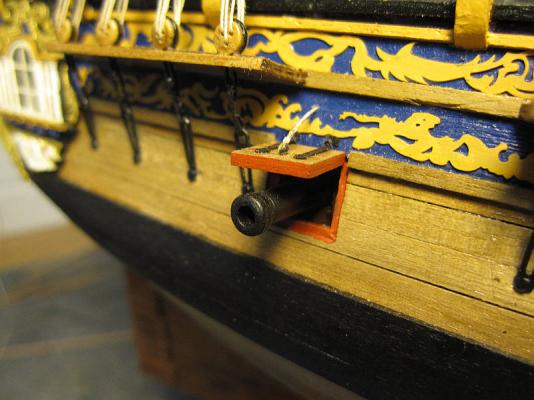
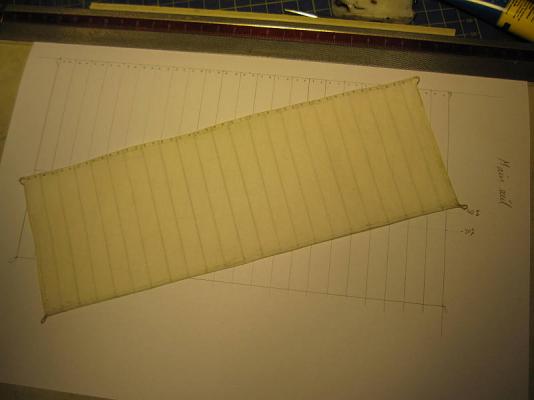
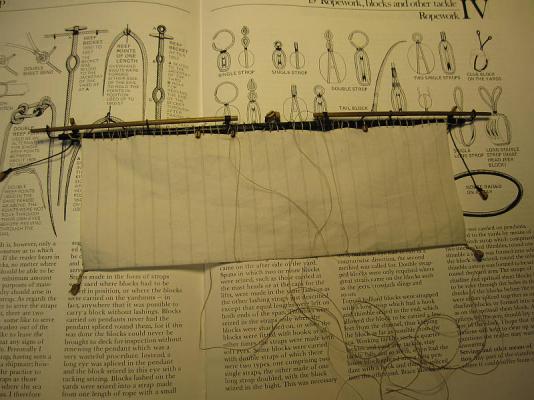
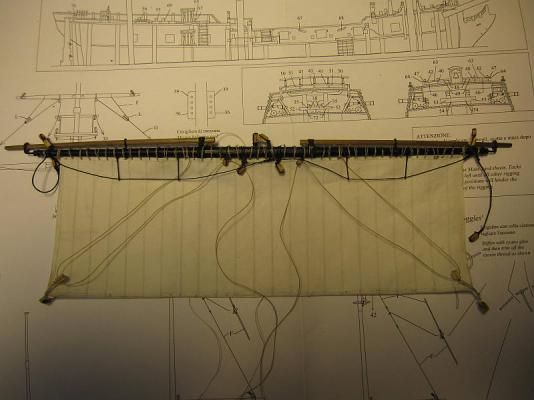
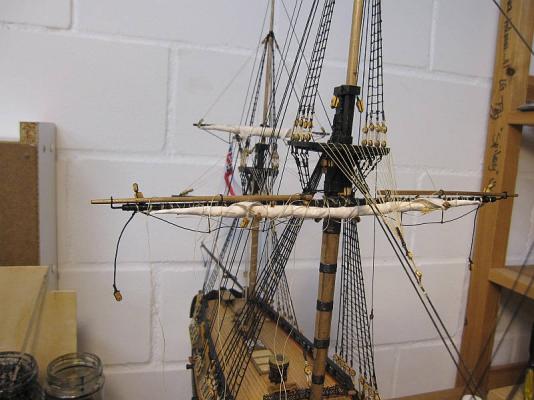
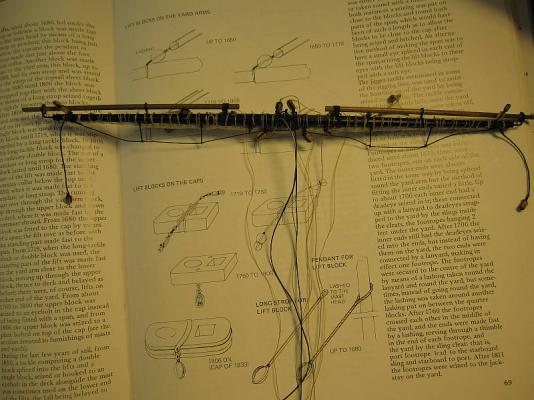
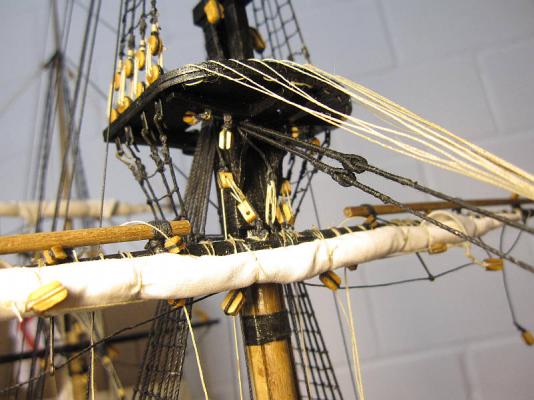
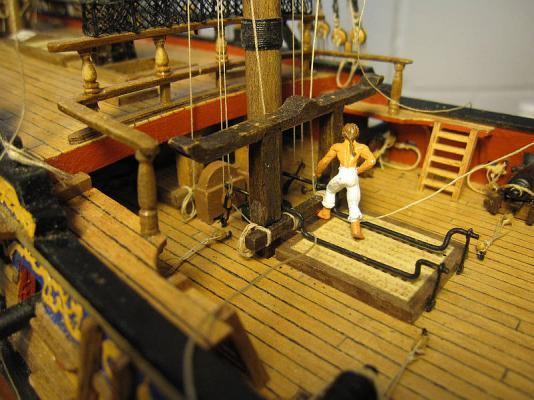
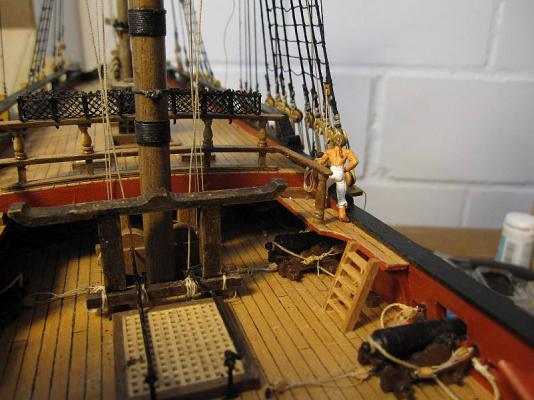
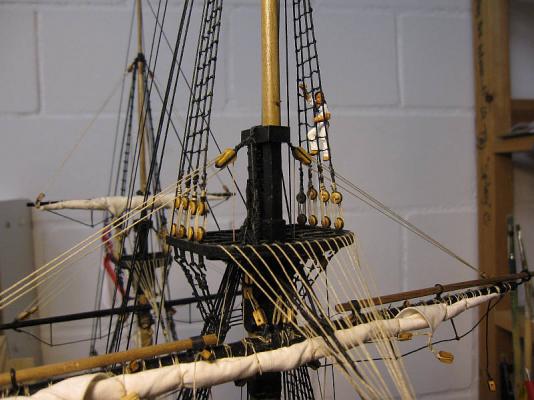
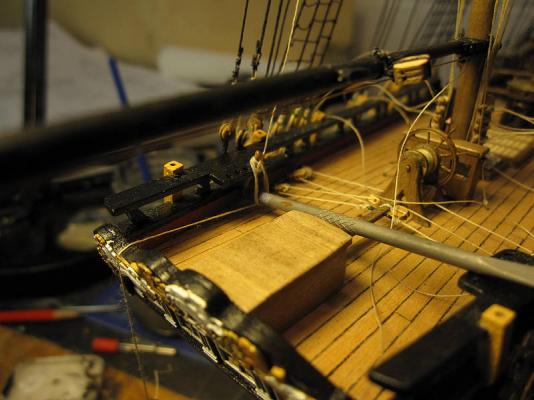
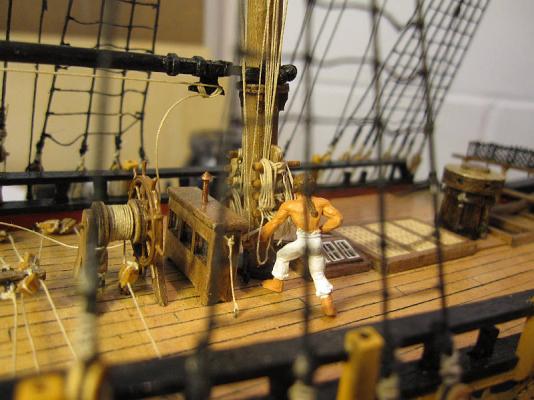
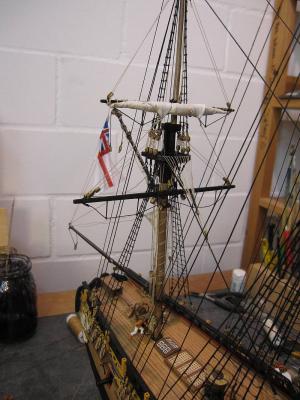
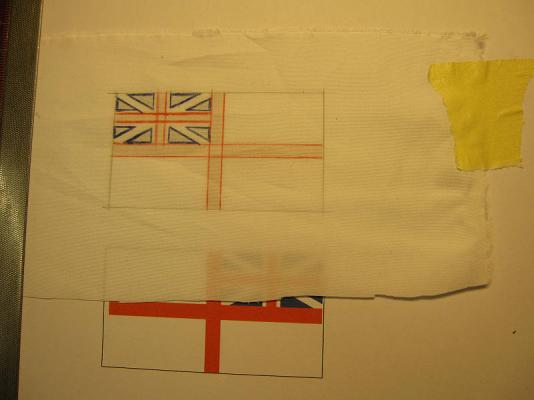
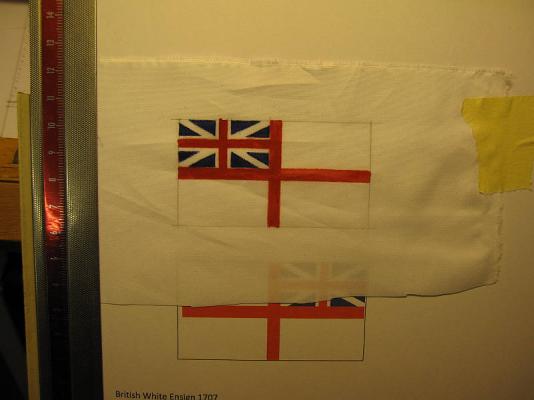

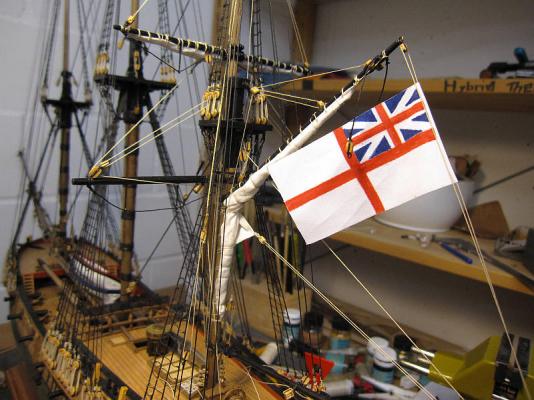
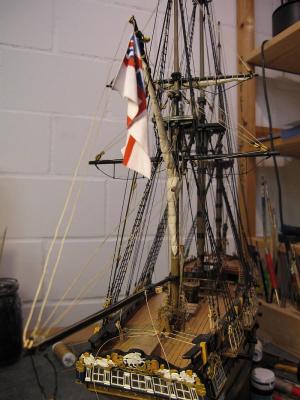
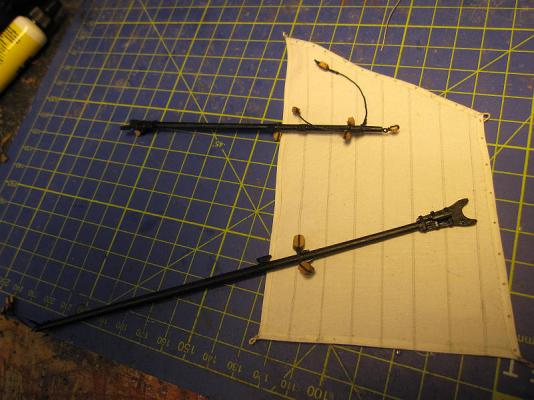
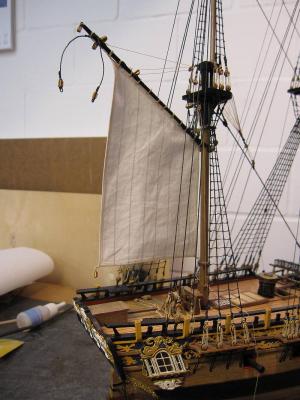

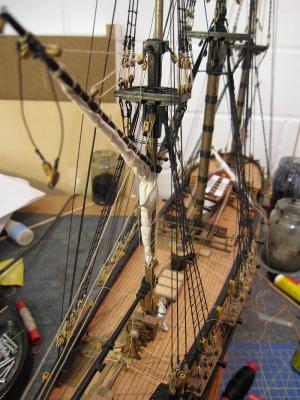
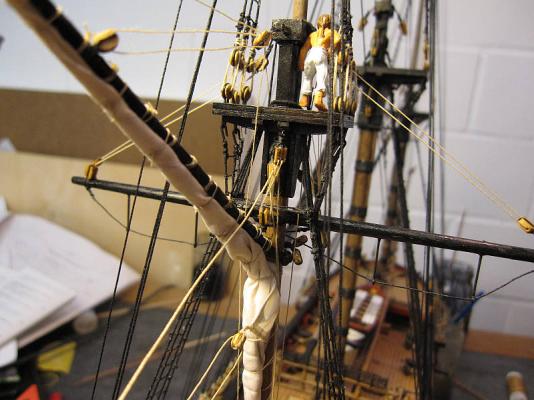
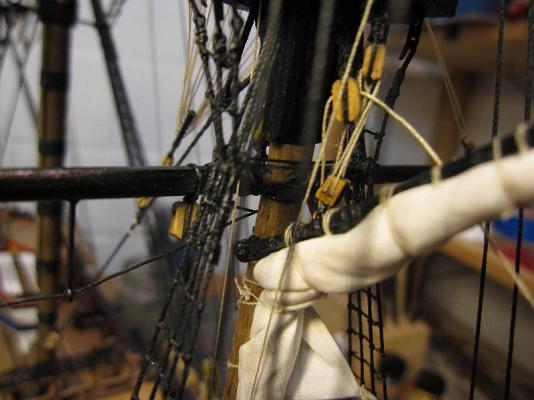
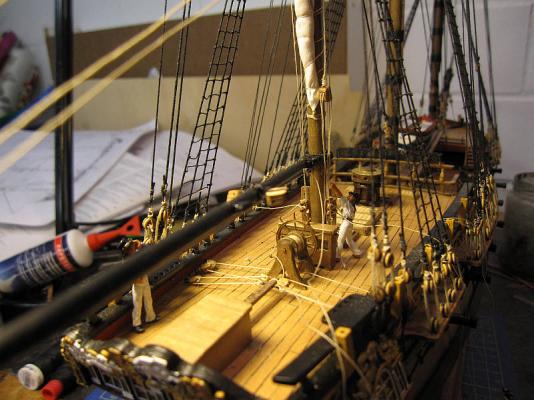
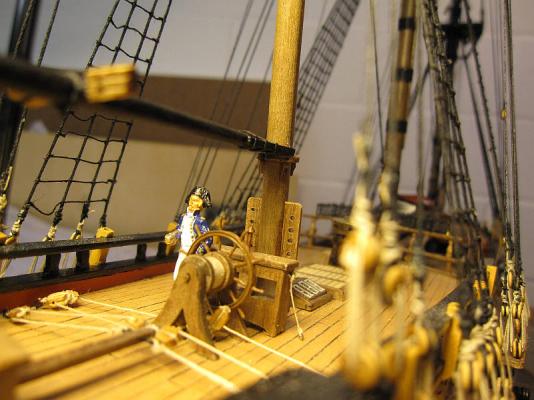
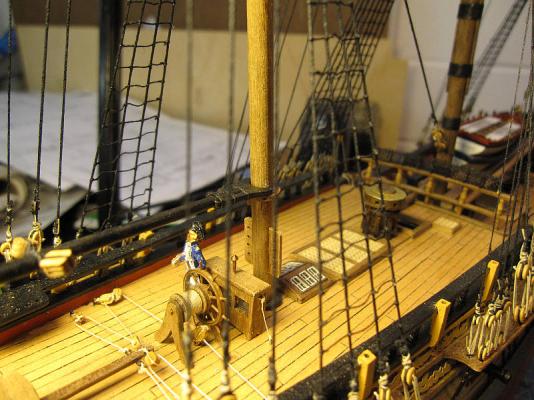

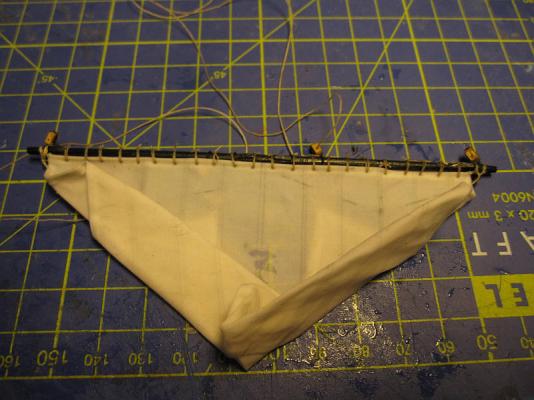
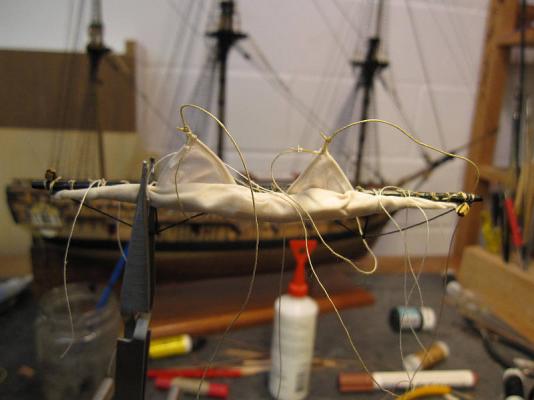
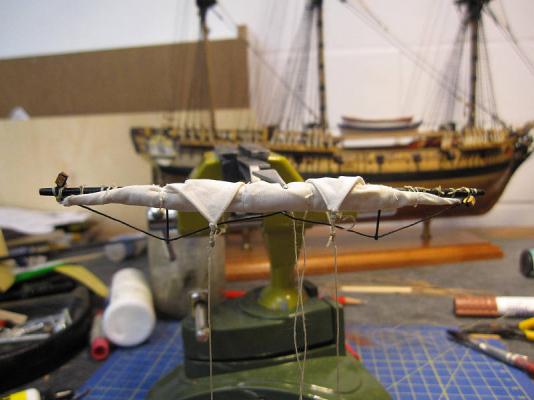
HMC Sherbourne 1763 by Gregor – FINISHED - Caldercraft – Scale 1:64 - first build
in - Kit build logs for subjects built from 1751 - 1800
Posted
Grüezi Gregor
After your visit on my log I had to have a look at yours – and it certainly is worth quite many more. Seeing how you improve that basically already excellent kit makes me once more proud to be a fellow citizen of that great seafaring nation: Switzerland.
Keep up the good work
Peter